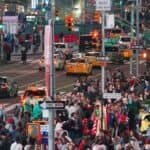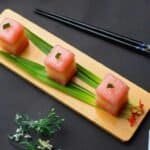Have you ever wondered what it’s like to step into a world where waterways replace roads and boats become shops? Thailand’s floating markets offer a sensory feast unlike anything you’ve experienced before. Imagine vibrant colors, the aroma of sizzling street food, and the rhythmic hum of boat engines as vendors paddle by. This is more than just shopping—it’s a journey into history.
These markets, like Damnoen Saduak and Amphawa, are living cultural treasures. They connect modern visitors to 19th-century trade traditions while offering fresh food, unique souvenirs, and unforgettable photography moments. Whether you’re a food lover, an adventurer, or a culture seeker, this is a must-do experience.
Important Considerations
- Immerse yourself in vibrant colors, fresh food aromas, and lively boat vendors.
- Damnoen Saduak is the most famous, while Amphawa offers a more relaxed vibe.
- Try must-eat dishes like boat noodles, mango sticky rice, and grilled seafood.
- Bring cash, arrive early, and wear comfortable clothing for the best experience.
- Don’t miss the chance to capture stunning photos of Thailand’s unique river culture.
Why Visit Thailand’s Floating Markets?
Trade crowded malls for a maze of waterways, where every turn reveals a new sensory delight. Here, coconut-hatted vendors paddle between boats piled with ripe mangoes, fragrant herbs, and sizzling skewers. It’s a unique experience that turns shopping into an adventure.
These vibrant hubs are more than tourist attractions—they’re guardians of authentic Thai culture. As cities modernize, the markets preserve century-old trading methods, from handwoven baskets to cash-free bartering. Your visit helps sustain these traditions against the tide of urbanization.
Golden-hour light dances on the canals, illuminating flower-decked boats and rainbow-hued produce. Every snapshot tells a story, whether it’s a vendor’s weathered hands or steam rising from a clay pot.
Best of all? Most are a day trip from Bangkok. Amphawa, for instance, lets you explore in the afternoon and return by sunset. Pack light, bring cash, and prepare to taste your way through grilled river prawns and sticky rice wrapped in banana leaves.
By supporting local fisherfolk and artisans, you’re part of ethical tourism. Each purchase feeds families and keeps this liquid legacy alive.
A Glimpse into the History of Thailand’s Floating Markets
Long before roads crisscrossed the land, waterways buzzed with commerce. In the 19th century, canals (“klongs”) were the lifeblood of trade, connecting farmers to cities like Bangkok. Farmers paddled boats laden with rice and tropical fruits, turning these liquid highways into bustling hubs of exchange.
From Trade Routes to Tourist Attractions
The Chao Phraya River was the heart of regional trade, with boats carrying goods long before trucks existed. But time brought change. Railways expanded after 1868, and canals faded—until their revival as cultural treasures.
Today, places like Damnoen Saduak blend old and new. Vendors still sell from boats, but now visitors snap photos of their vibrant stalls. Some markets even operate at dawn for locals before tourists arrive.
The Role of Canals in Thai Culture
Canals are woven into Thailand’s identity. Festivals celebrate water’s symbolism, and Bangkok earned the nickname “Venice of the East”. Every ripple tells a story—of trade, tradition, and resilience.
| Era | Canal Use | Key Change |
|---|---|---|
| 19th Century | Trade routes for farmers | Primary transport for goods |
| 20th Century | Decline due to railways | Shift to cultural tourism |
| Present Day | Mixed-use (trade + tourism) | Preservation of heritage |
These waterways are more than relics—they’re living history. Your visit helps keep centuries of tradition afloat.
Top Floating Markets to Visit
Ready to explore the most vibrant water-based bazaars in Thailand? Each offers a distinct vibe, from bustling morning trade to twilight seafood feasts. Here’s where to go for an unforgettable day on the water.
Damnoen Saduak: The Iconic Choice
Arrive by 7 AM to beat the crowds at this legendary spot. Wooden long-tail boats selling mango sticky rice and pad Thai weave through canals, their vendors clad in traditional cone hats. Private tours (฿500–฿800/hour) let you navigate freely—just avoid the 9 AM rush.
Amphawa: A Seafood Lover’s Paradise
Open Friday–Sunday afternoons, this maeklong riverside gem thrives on grilled squid and fishcakes. Pair your visit with a firefly tour (฿60–฿100) as the sun sets. *Pro tip*: Bring cash—many stalls don’t accept cards.
Maeklong Railway Market: Where Trains Meet Stalls
Vendors here fold their awnings eight times daily for passing trains. Snack on coconut ice cream while watching the 11:10 AM or 2:30 PM crossings. Stay behind the red safety line—and hydrate, as shade is scarce.
- Price check: Damnoen Saduak costs 20–30% more than Amphawa for similar items.
- Best time: Dawn for Damnoen Saduak; late afternoon for Amphawa’s seafood.
- Unique perk: Maeklong’s train spectacle doubles as a cultural photo op.
Must-Try Foods at Thailand’s Floating Markets
Every turn offers a new culinary adventure, with dishes as vibrant as the boats they’re served from. Whether you crave sweet, spicy, or savory, the floating market experience is a feast for all senses.
Sweet Treats and Local Delicacies
At Damnoen Saduak, bite into crispy coconut pancakes (฿20) or khanom krok—mini custards with a caramelized crust. Don’t miss rainbow-layered khanom chan or flower-shaped coconut ice cream, perfect for Instagram.
For a traditional dessert, try khanom buang at Bang Nam Phueng. These crispy crepes fold in sweet meringue and savory toppings.
Fresh Seafood and Street Food Favorites
Amphawa shines with honey-roasted squid (฿100) and som tum papaya salad. Grilled river prawns, prized for their size, are a must-try. Pair them with sticky rice wrapped in banana leaves for an authentic bite.
At Khlong Lat Mayom, crispy oyster omelettes (hoi tod) and salt-crusted fish retain juicy perfection. Pro tip: Use both hands to accept food from vendors—it’s a sign of respect.
- Spice warning: Ask for “mai phet” to tame fiery curries or salads.
- Vegetarian? Try Amphawa’s mushroom satay or jackfruit salads at Maeklong.
- Cash is king: Most stalls don’t accept cards.
How to Make the Most of Your Floating Market Experience
Timing is everything when exploring these vibrant waterway hubs. With smart planning, you’ll enjoy authentic interactions and better deals while avoiding tourist crowds. These pro tips will transform your trip from good to unforgettable.
Best Times to Visit
Arrive at Damnoen Saduak by 7 AM to secure boat rentals before prices jump 15-20% after 10 AM. For Amphawa, late afternoon offers cooler temperatures and stunning sunset views over the canals.
Maeklong’s train crossings happen eight times daily—download the schedule via Klook app to plan your day. Early birds also find fresher food selections and more photo opportunities.
Tips for Navigating the Markets
Wear slip-on shoes for easy boarding of boats and moisture-wicking fabrics to stay cool. Bring small bills—most vendors don’t accept cards, and restrooms require exact change (฿5-฿10).
When negotiating, politely counter with 60% of the initial price. If vendors refuse, smile and walk away—you’ll often get called back with a better offer.
Look for stalls with high customer turnover to ensure food freshness. A reusable water bottle helps reduce plastic waste while keeping you hydrated.
Beyond the Markets: Nearby Attractions to Explore
Extend your adventure beyond the waterways with these hidden gems near Bangkok’s iconic markets. Just 15 minutes by boat from Don Wai, Wat Rai Khing mesmerizes with its golden Buddha statue and peaceful riverside setting. For nature lovers, Bang Kachao—Bangkok’s “Green Lung”—offers lush bike trails through Sri Nakhon Khuean Khan Park.
Pair your Damnoen Saduak visit with the Rose Garden Thai Village. Watch traditional dance shows and muay Thai demonstrations for ฿300. After Amphawa, drive 30 minutes to Wat Bang Kung—a temple entirely embraced by banyan tree roots.
For unique day trips, combine Maeklong with Samut Songkhram. See salt farms glisten at sunrise and coconut sugar workshops where locals stir caramel-colored syrup over wood fires. Guided tours like TakeMeTour offer insider access to pomelo orchards and kite-making villages.
Pro tip: Visit Asita Eco Resort near Amphawa for canal-side massages after market hopping. Their bamboo bikes let you explore rural trails dotted with lotus ponds.
Conclusion
Exploring these vibrant waterways offers more than shopping—it’s a journey into Thai culture. From Amphawa’s grilled seafood to Damnoen Saduak’s colorful boats, each moment connects you to traditions that have thrived for generations.
Remember to support local vendors directly. Skip plastic bags and bring reusable containers to protect these delicate ecosystems. Your visit helps preserve a way of life that modern cities often overshadow.
Ready for an unforgettable trip? The scent of lemongrass and sizzling prawns beckons. Book your tour today and dive into this living guide to Thailand’s past and present.
FAQ
What is the best time to visit Damnoen Saduak?
Early morning, between 7 AM and 9 AM, is ideal. The crowds are smaller, and the boats are fully stocked with fresh goods.
How do I get to Amphawa from Bangkok?
You can take a minivan from Victory Monument or book a guided tour. The trip takes about 1.5 to 2 hours.
Is Maeklong Railway Market safe to visit?
Yes! Vendors quickly retract their stalls when the train passes, making it a thrilling but safe experience.
What should I buy at these markets?
Look for handmade souvenirs, tropical fruits, and local snacks like coconut pancakes or grilled river prawns.
Are the boat rides expensive?
Prices vary, but a private longtail boat ride at Damnoen Saduak costs around 500-800 THB for 30-45 minutes.
Can I haggle with vendors?
Yes, bargaining is common, especially for souvenirs. Stay polite and aim for a fair price.
What’s unique about Amphawa compared to other markets?
Amphawa is famous for its evening seafood stalls and firefly boat tours, offering a magical nighttime experience.
How long should I spend at Maeklong Railway Market?
About 1-2 hours is enough to explore the stalls and witness the iconic train passing through.

































